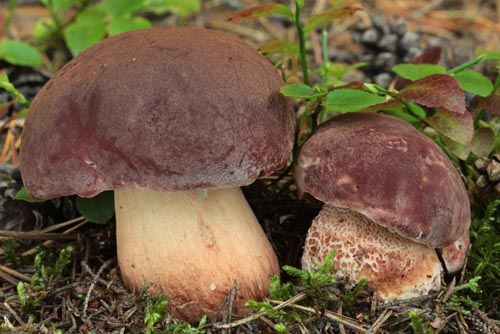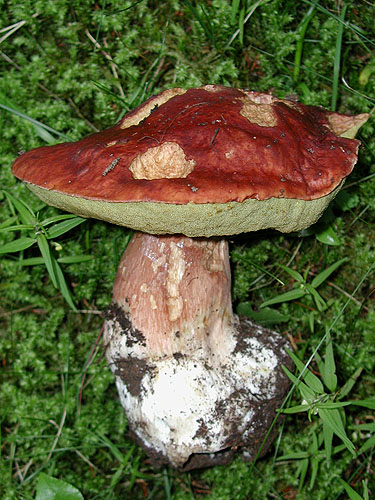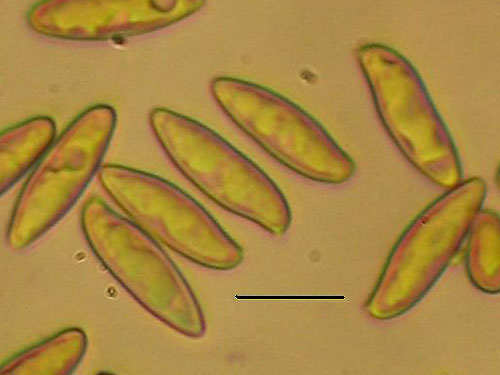Boletus L.
Recent molecular studies have shown that Boletus in its current circumscription is likely an artificial grouping and it is possible that it will be split at some point into smaller genera. Note that Boletus impolitus and Boletus depilatus for practical reasons are retained here, although there is strong evidence that they are closely related to Xerocomus subtomentosus and its allies.
Fruitbody large to medium sized, boletoid, without veil and ring. Stipe solid, with surface usually covered with granules or network. Flesh variously coloured, changing or not when exposed to air. Tubes easily separable from each other, not tearing apart. Pores usually small and rounded.
Boletus pinophilus Pilát & Dermek
Description
Cap up to 20 cm, hemispherical, later convex, flattened, rarely flat, usually wrinkled, rarely smooth, dry to slightly viscid, vinaceous brown to reddish brown, unchanging when bruised. Stipe clavate, often swollen, concolorous but slightly paler than the cap, with well developed network. Flesh white, sometimes with brownish or yellowish spots in the stipe base, often pinkish to pale vinaceous below the cap cuticle, unchanging when exposed to air. Tubes initially white, then cream, pale yellow to yellow with olivaceous tint, unchanging when exposed to air. Pores concolorous with the tubes, unchanging when bruised. Smell not distinctive. Taste not distinctive. Spores 13.0–21.0 × 3.5–6.5 μm, ratio 2.7–4.3. Pileipellis trichodermium of interwoven of septate and usually slightly gelatinized hyphae. Cells of the hyphae short cylindrical, not incrusted. Chemical reactions: Hyphae of the flesh in the stipe base inamyloid with Melzer’s reagent.
Habitat. Coniferous or mixed forests, mycorrhizal with pines (Pinus) or spruce (Picea).
Distribution. In Europe widespread, more mountain species in south.
Photographs

Fruitbodies of Boletus pinophilus. Note the cap and the stipe colours. (photo B. Assyov)

Fruitbodies of Boletus pinophilus. (photo M. Mikšík)

Fully developed fruitbody of Boletus pinophilus. (photo B. Assyov)

Fruitbody of Boletus pinophilus. (photo B. Assyov)

Fruitbody of Boletus pinophilus. (photo M. Mikšík)

Boletus pinophilus - spores. Scale bar = 10 μm. (photo B. Assyov)
Important literature
Alessio, C.L. 1985. Boletus Dill. ex L. (sensu lato). – In: Fungi Europaei. Vol. 2. Pp. 1–705. Libreria editrice Biella Giovanna, Saronno.
Breitenbach J. & Kränzlin F. 1991. Pilze der Schweiz. Bd. 3(1). Röhrlinge und Blätterpilze. Verlag Mykologia, Luzern.
Dentinger, B.T.M., Ammirati, J.F., Both, E.E, Desjardin, D.E., Halling, R.E., Henkel, T.W., Moreau, P.-A., Nagasawa, E., Soytong, K., Taylor, A.F., Watling, R., Moncalvo, J.M. & McLaughlin, D.J. 2010. Molecular phylogenetics of porcini mushrooms (Boletus section Boletus). – Molecular Phylogenetics and Evolution 57: 1276–1292. (available online)
Engel, H., Krieglsteiner, G., Dermek, A. & Watling, R. 1983. Dickröhrlinge. Die Gattung Boletus in Europa. Verlag Heinz Engel, Weidhausen b. Coburg.
Estadès, A. & Lannoy, G. 2004. Les bolets européens. – Bulletin Mycologique et Botanique Dauphiné-Savoie 44(3): 3–79.
Galli, R. 1998. I Boleti. Atlante pratico-monographico per la determinazione dei boleti. Edinatura, Milano.
Hansen, L. & Knudsen, H. 1992. Nordic Macromycetes. Vol. 2. Polyporales, Boletales, Agaricales, Russulales. Nordsvamp, Copenhagen.
Korhonen, M., Liimatainen, K. & Niskanen, T. 2009: A new boletoid fungus, Boletus pinetorum, in the Boletus section Boletus from Fennoscandia (Basidiomycota, Boletales). – Karstenia 49: 41–60.
Knudsen, H. & Vesterholt, J. [eds.]. 2008. Funga Nordica. Nordsvamp, Kopenhagen.
Lannoy, G. & Estadès, A. 2001. Les Bolets. Flore mycologique d’Europe. Documents Mycologiques Mémoire Hors série no. 6. Pp. 1–163. Association d’Écologie et de Mycologie, Lille.
Muñoz, J.A. 2005. Boletus s. l. – In: Fungi Europaei. Vol. 1. Pp. 1–951. Edizioni Candusso, Alassio.
Pilát, A. 1973. Boletus pinophilus nomen novum pro Boletum pinicolam (Vittadini 1835) Venturi 1836. – Česká Mykologie 27: 6–8.
Pilát, A. & Dermek, A. 1974. Hríbovité huby. Československé hríbovité a sliziakovité huby (Boletaceae – Gomphidiaceae). Veda, Bratislava.
Singer, R. 1967. Die Röhrlinge. II. Die Boletoideae und Strobilomycetaceae. – In: Die Pilze Mitteleuropas. Vol. 6. Pp. 1–151. Julius Klinkhardt Verlag, Bad Heilbrunn.
Šutara, J., Mikšík, M. & Janda, V. 2009. Hřibovité houby. Čeled’ Boletaceae a rody Gyrodon, Gyroporus, Boletinus a Suillus. Academia, Praha.
Watling, R. 1970. Boletaceae, Gomphidiaceae, Paxillaceae. – In: Henderson, D.M., Orton, P.D. & Watling, R. [eds]. British fungus flora. Agarics and Boleti. Vol. 1. Royal Botanic Garden, Edinburgh.
Watling, R. & Hills, A.E. 2005. Boletes and their allies (revised and enlarged edition). – In: Henderson, D.M., Orton, P.D. & Watling, R. [eds]. British Fungus Flora. Agarics and boleti. Vol. 1. Royal Botanic Garden, Edinburgh.